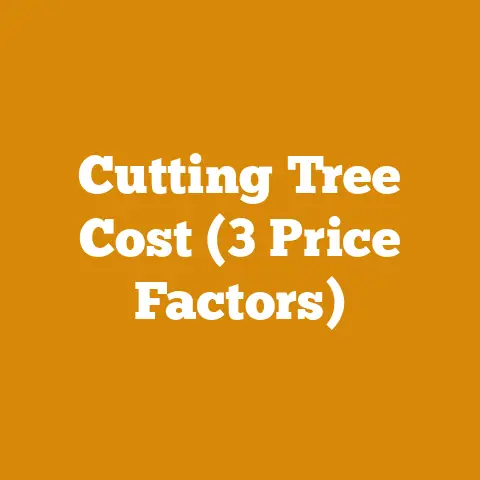DIY Tree Pruner (4 Secrets the Pros Use)
Challenging the Misconception
Many folks think you can just grab any old pruner and start cutting away at your trees. But let me tell you from experience, there’s a lot more to it than that. It’s not just about cutting branches; it’s about understanding your trees and using the right techniques. Are you ready to learn the secrets the pros use? Let’s dig in!
Secret 1: Choosing the Right Tool
Selecting the right tool is the first step toward successful tree pruning. The tool you choose can make or break your pruning project. Which one should you pick?
Types of Pruners
- Bypass Pruners: These are like scissors for trees. They have two blades that bypass each other to make a clean cut. They’re great for live branches because they don’t crush the plant tissue.
- Anvil Pruners: These have a single straight blade that closes onto a flat edge or ‘anvil’. They’re best for deadwood since they tend to crush rather than cut cleanly.
- Pole Pruners: Got branches way up high? Pole pruners let you reach those tricky spots without a ladder.
Personal Stories
Once, I decided to tackle a stubborn old oak tree in my backyard. I thought an anvil pruner would do the trick for everything. Big mistake! It crushed the live branches, leaving them ragged and open to disease. Switching to a bypass pruner made all the difference. The cuts were clean, and the tree was much happier for it.
Pro Tips
- Match your pruner type to the specific job.
- Regularly sharpen your tools for the best performance.
- Clean your pruners after each use to prevent disease spread.
Safety Callouts
- Always wear gloves to protect your hands from blisters and cuts.
- Safety goggles are a must to shield your eyes from flying debris.
Questions to Consider
- Do you have the right tools for your trees?
- Are your pruners in good working condition?
Secret 2: Timing is Everything
The timing of your pruning can greatly impact the health and growth of your trees. Do you know when the best time is to prune different types of trees?
Optimal Pruning Times
- Spring: Perfect for flowering trees right after they bloom. This helps shape them and encourage future blossoms.
- Winter: Most trees are dormant in winter, making it an ideal time for major pruning without stressing the tree.
- Summer: Use summer pruning to control growth and remove diseased or damaged limbs.
Why Timing Matters
Pruning at the wrong time can hurt your tree, causing stress or making it vulnerable to disease. I once pruned a cherry tree in full bloom during spring. It looked beautiful at first, but I inadvertently caused stress, and it didn’t bloom as well the following year.
Warnings
- Avoid pruning in fall; it can encourage new growth just before winter, which could lead to damage.
Personal Experiences
I remember a time with a stubborn elm that I pruned in summer to control its growth. It was a hot day, and I had planned to work quickly. As I was cutting away, I noticed how much easier it was to spot which branches needed removal. The tree responded well, and by fall, it looked healthier than ever.
Engaging Questions
- Have you ever noticed how different trees respond to pruning at different times?
- What time of year do you usually prune?
Secret 3: The Perfect Cut
Making the right cut is an art form in itself. A poor cut can leave your tree vulnerable to decay or disease. Want to learn how to make perfect cuts every time?
Step-by-Step Cutting Guide
- Locate the Branch Collar: This is where the branch meets the trunk or another branch. It’s crucial not to cut into this area as it helps with wound healing.
- Make an Undercut: About one-third of the way through the branch, 6-12 inches from the collar. This prevents tearing when you make your final cut.
- Complete the Cut: Start from the top, a few inches beyond the undercut, and cut all the way through.
- Finish at the Collar: Make your final cut just outside the branch collar without leaving a stub.
Safety Precautions
- Use stable ladders or platforms.
- Keep both feet on solid ground whenever possible.
Troubleshooting Tips
- If your cuts aren’t smooth, check if your blades are sharp enough.
- For larger branches, consider using a saw for more control and cleaner cuts.
Detailed Insights
One time, I was working on an old walnut tree using these techniques. The previous owner had left stubs all over it, leading to decay in several areas. By carefully removing these stubs and cutting back to the collar, I managed not only to stop further decay but also saw new growth in those areas within a year.
Interactive Questions
- Have you ever struggled with clean cuts?
- What do you find most challenging about making precise cuts?
Secret 4: Maintain Your Equipment
Like any relationship, maintenance is key! Your pruners need care just like any other tool in your kit.
Maintenance Checklist
- Clean After Each Use: Wipe down with a damp cloth to remove sap and debris.
- Sharpen Regularly: Use a sharpening stone or file; dull blades make rough cuts.
- Oil Moving Parts: This prevents rust and ensures smooth operation.
Common Questions
- How often should I sharpen my pruners? Every few months or when they start feeling dull.
- What oil should I use? WD-40 or any light machine oil works well.
Best Practices
- Store in a dry place to prevent rust.
- Inspect for wear and damage before each use.
Pro Stories
I’ve seen too many folks neglect their tools until they’re practically unusable. My grandfather taught me early on that a well-maintained tool not only lasts longer but also makes your work so much easier. I’ve kept some of his pruners in great shape, decades after he last used them.
Prerequisites and Required Materials
Before diving into pruning, here’s what you’ll need:
- Pruners (Bypass, Anvil, or Pole)
- Gloves and Safety Goggles
- Ladder or Stable Platform
- Sharpening Stone or File
- Lubricating Oil
Prerequisite Knowledge
Understanding basic tree anatomy is important. Know what a branch collar is and recognize signs of disease or distress in trees.
Interactive Thought
- Have you got all your tools ready?
- Do you feel prepared with the knowledge needed?
Important Reminders and Next Steps
Remember, pruning isn’t just about cutting branches off willy-nilly. It’s about understanding each tree’s needs and respecting its natural growth patterns. Now that you’re armed with these secrets, you’ll be pruning like a pro in no time!
Next Steps
- Review your trees and plan which ones need attention.
- Gather your tools and inspect them thoroughly.
- Set aside time when you’re not rushed; quality work takes time.
FAQ Section
Q: Can I prune my tree anytime? A: It’s best to follow seasonal guidelines to avoid stressing the tree unnecessarily.
Q: What if I accidentally cut too much? A: Monitor the tree’s health closely and adjust future pruning practices to encourage recovery.
Q: How do I know if my pruner is sharp enough? A: If it’s not cutting smoothly or is crushing branches instead of slicing them cleanly, it’s time to sharpen.
Q: Is there a “wrong” way to prune? A: Yes! Cutting into the branch collar or leaving long stubs can harm your tree’s health.
Q: Can improper pruning kill a tree? A: While rare, severe improper pruning can lead to significant stress or disease that might result in death over time.
So, are you ready to tackle your next pruning project with confidence? With these secrets in your toolkit, nothing’s stopping you from becoming a pruning pro!






